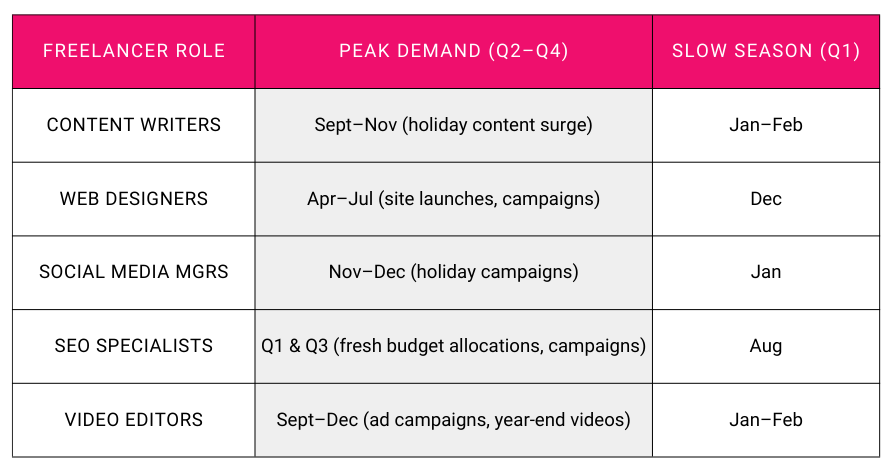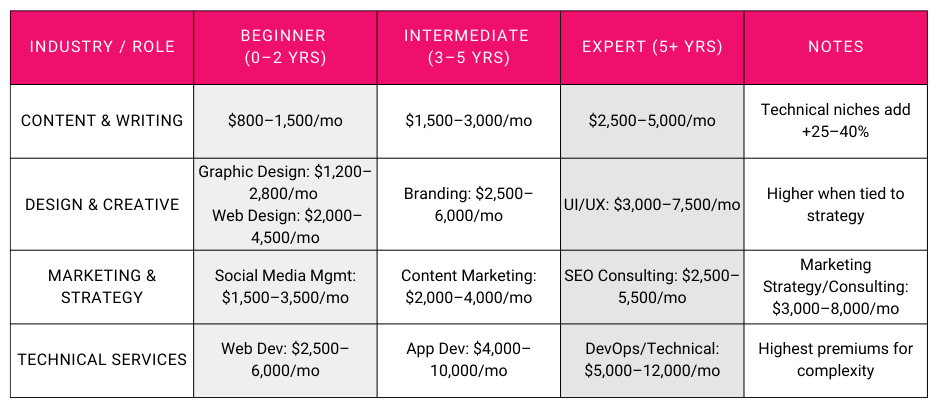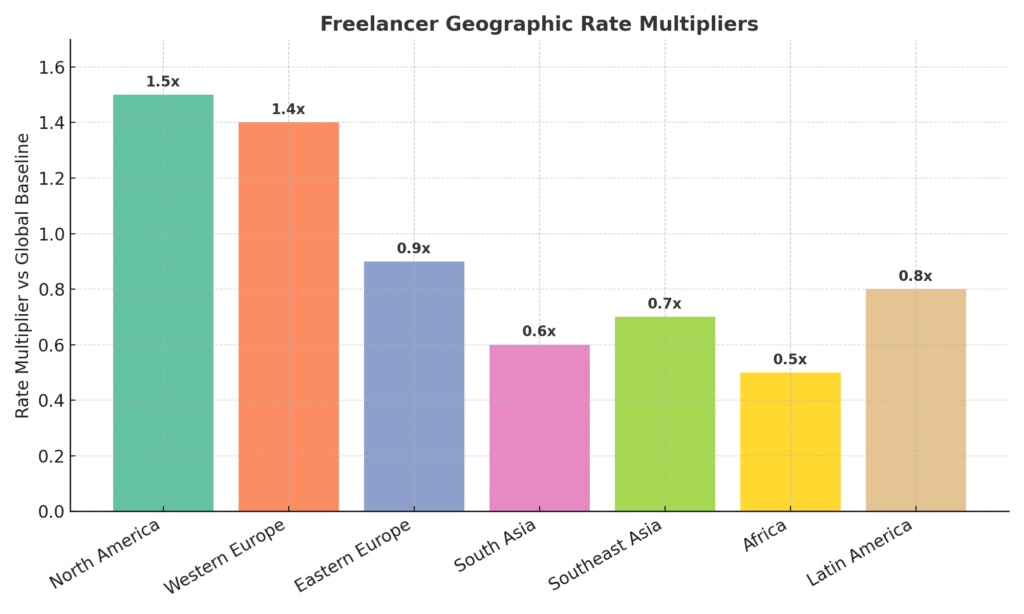“Last week, I analyzed 200 freelance retainer pricing agreements posted in online communities. The results were shocking: 90% contained the same three mathematical errors that cost freelancers an average of $847 per month in lost income.”
90% of freelancers underprice retainers and end up working 30–50% more than they’re paid for.
Statistical Foundation:
- “64% of freelancers charge below $1,000/month for retainers, with 30% charging less than $500/month”
- “The average freelancer underprices retainers by 23-67% compared to project equivalent rates”
- “99% of employers plan to hire more freelancers in 2025” – but most want predictable costs (retainers)
In this guide, I’ll show you the exact formula successful freelancers use to price retainers that clients happily pay while ensuring you never leave money on the table again.
The 4 Biggest Mistakes Freelancers Make with Retainers
If you’re like most freelancers, retainers feel like the golden ticket: stable income, less hustle, predictable workload. But here’s the truth is 90% of freelancers still price them wrong. And the result is lost income, overwork, and frustrated clients.
Mistake #1: The Hourly × Hours Trap
Most freelancers fall into the simplest and most damaging retainer pricing mistake, multiplying their hourly rate by an estimated number of hours.
On paper, it looks logical:
“I charge $50/hour. The client needs about 20 hours per month. That’s $1,000/month.”
This sounds good until reality hits. Retainer clients expect priority responses, extra revisions, strategy calls, and “quick favors.” If you don’t account for those, you’re effectively working 25–30% more hours than you’re being paid for.
Wrong vs. Right: The Real Math
Here’s what this mistake looks like in numbers:

That “tiny” $437/month difference translates to more than $5,000 per year — from just one client. If you’re managing three such clients, that’s $15,000+ left on the table annually.
Why This Happens
Freelancers think they’re giving clients a deal by offering retainers at a “discounted hourly bundle.” But the client isn’t buying hours but they’re buying priority, access, and guaranteed outcomes.
Fix: Always apply a scope buffer (1.15–1.25×) for hidden work and a stability premium (1.10–1.20×) for the guaranteed access you provide.
Mistake #2: Ignoring Scope Creep & Hidden Work
Scope creep isn’t just about big changes — it’s the daily drip of small extras: an extra graphic, “just one more revision,” or 30 minutes on Slack. Over a month, those unbilled extras add up to entire lost days.
Without an overage clause or buffer, freelancers end up eroding their effective hourly rate by 20–40%.
A designer charging $1,000 per month for 10 hours of work may end up working 15 hours. This reduces their effective rate from $100 per hour to $66 per hour, resulting in a loss of $400 each month—or $4,800 per year.
Fix: Every retainer should define boundaries (e.g., “Includes up to 10 hours/month; additional work billed at $90/hr”). This sets expectations and protects your effective rate.
Mistake #3: Seasonal Demand Blind Spot
Many freelancers forget that not all months are equal. Retainer planning should factor in when clients naturally pull back or ramp up their budgets.

What this means:
If you’re a social media manager, December might feel like a gold rush, but January will dry up. A smart retainer plan smooths out those spikes by locking clients into steady commitments — so you’re not scrambling in slow months.
Mistake #4: The Client Psychology Error
The last (and most subtle) mistake is how retainers are framed. Many freelancers pitch them as “bulk hours at a discount.” To clients, that feels like an expense.
Instead, retainers must be positioned as an investment — one that buys them faster turnarounds, predictable budgets, and measurable ROI.
Example
- A Social media manager charges $2,000/mo as a retainer. But the client canceled after 3 months, saying, “We’re not seeing ROI.”
- But in reality, the work actually generated $15,000 in new leads, but ROI wasn’t tracked or communicated.
- The new way should be $2,400 a month plus monthly ROI reports. If the client renews for 12 months, they will keep $28,800 a year instead of losing $6,000.
Fix: Track ROI and frame retainers as “priority access + measurable results.” Clients justify them as an ongoing investment, not just a sunk cost.
Results:
These four mistakes, hour-based pricing, unchecked scope creep, seasonal blind spots, and weak positioning, are the reasons for 90% of freelance retainer pricing being underquoted. The fix isn’t working harder; it’s applying the right math, buffers, and psychology so you capture the full value of what you offer.
The Retainer Revenue Formula: Math That Works
If freelance retainer pricing feels like guesswork, you’re not alone. Most freelancers either oversimplify (hourly × hours) or overcomplicate (random add-ons without structure). Both approaches leave money on the table.
The truth is, profitable retainers follow a repeatable formula. Once you understand the variables, you can price confidently — and show clients the math behind your proposal.
The Complete Formula
Optimal Retainer = Base Rate × Market Multiplier × Complexity Premium × Stability Buffer + Risk Protection
Let’s break that down:
- Base Rate = (Hourly Rate × Monthly Hours × Scope Buffer 1.15–1.25)
- Covers your core workload plus inevitable hidden hours.
- Example: $75/hr × 25 hrs × 1.20 buffer = $2,250/mo
- Market Multiplier (0.85–1.40)
- Adjusts for industry and location.
- Web dev in high demand → ×1.25–1.40.
- Content writing in saturated markets → ×0.95–1.10.
- Complexity Premium (1.00–1.35)
- Reflects the specialized, strategic, or technical nature of the work.
- Routine design = ×1.00.
- Strategic marketing = ×1.20+.
- Stability Buffer (1.10–1.20)
- Clients pay for predictable access and reduced turnaround time.
- This buffer compensates for your guaranteed availability.
- Risk Protection (+$200–500 flat)
- Safety net for late payments, cancellations, or extra emergencies.
- Small cost for client, huge peace of mind for you.
Why This Formula Works
- Its objective is to identify each factor’s logic (scope, market, complexity, stability).
- It’s defensible: You can walk clients through the math and justify the price.
- It’s scalable: Works across industries — just adjust multipliers.
Clients don’t balk at higher retainers when they see:
- Reduced turnaround times,
- ROI framing,
- And your guaranteed availability.
They start to view the retainer as an investment instead of an expense.
Key Takeaway: Freelance retianer pricing isn’t random. By applying the right buffers and premiums, you capture your full value and protect against hidden risks.
Freelance Retainer Pricing Benchmarks and Industry Data (2025)
Freelance retainer pricing ranges vary widely depending on field, experience, and specialization.

How to use this: If you’re charging significantly below these ranges for your skill set, you’re underpriced.
Geographic Multipliers
Location still matters — both for client budgets and freelancer positioning.

The Revenue Impact of Switching
Freelancers who successfully transition to retainers don’t just “raise their rates.” They eliminate unpaid business development time and feast-or-famine stress.
- Average income increase: +35–60% within 12 months
- Reason: Fewer dry months + fewer unpaid hours chasing projects
- Side benefit: 15–20 hrs/month saved on proposals & prospecting
For clients: They build legitimacy. Quoting $3,000/month for SEO feels different when you can say: “That’s well within the $2,500–$5,500/month industry benchmark for SEO consulting.”
Transition Clients to Retainers Without Losing Them
Knowing the right numbers is only half the battle. The bigger challenge? Convincing your existing clients to switch from ad-hoc projects or hourly billing to a monthly retainer.
Many freelancers lose clients at the retainer negotiation stage. The key is to make retainers feel like a win-win, not a trap. Here’s a simple checklist you can follow:
Here is the Client Transition Checklist
- Start Small → Offer 1-month trial retainer
- Show ROI → Share past project results
- Frame as Stability → Priority access + predictable outcomes
- Offer Flexibility → Limited scope adjustments allowed
- Tiered Options → Basic, Growth, Premium packages
- Position as Partnership → Long-term outcomes, not just tasks
Success metric: If you start with 5 clients, expect 2–3 to say yes in the first month. That’s a 40–60% conversion rate — right in line with industry data.
The Long-Term Payoff of Pricing Retainers Right
When you price retainers correctly, you do more than lock in predictable income — you set up your freelancing business for stability and growth.
- Steady Cash Flow → No more feast-and-famine cycle.
- Deeper Client Trust → Clients stick when they see consistent results.
- Higher Lifetime Value → Retainers often outlast short projects by 6–12 months.
- Room to Scale → Reliable income lets you hire help, upgrade tools, and grow.
- Future-Proofing → Even in slow seasons, retainers keep the bills paid.
In short: a well-structured retainer is not just a deal — it’s your safety net and your growth engine.
Conclusion: Stop Guessing, Start Pricing Retainers Right
If you’ve made it this far, you already know the truth: 90% of freelancers are underpricing their retainers — sometimes by thousands of dollars a year.
The four mistakes (bad math, scope creep, seasonal blind spots, and weak ROI framing) quietly drain income and add stress. The fix is simple: use better math, add buffers, and frame retainers as investments.
When you get this right, everything changes:
- Your income becomes predictable.
- You need fewer clients to hit your goals.
- You stop chasing projects and start running a business.
Your Next Step
That’s why I’m creating a Retainer Pricing Calculator — a simple tool that runs all the math, applies the right buffers, and gives you a client-ready number in minutes.
Want early access?
- Download the Free Freelance Retainer Pricing Worksheet today (quick win).
- You’ll also get priority access to the Calculator demo the moment it’s ready.
Stop guessing. Start pricing your retainers with confidence — and finally earn what your work is worth.

